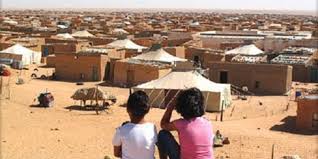Dakhla, April 2025, every time representatives of MINURSO visit the Tindouf camps, the same scene unfolds, almost theatrical in nature.
« Thousands » of alleged Sahrawis appear as if by magic, waving political slogans and Polisario banners. This crowd, supposedly representing the voice of the Sahrawi people, manages to impress foreign observers. But behind this carefully orchestrated performance by the Algerian military regime lies a much different, and far less flattering, reality.
In truth, the permanent population of the Tindouf camps reportedly does not exceed 18,000 people, according to various regional sources and independent witnesses.
A large portion of these residents are not even of Sahrawi origin, but rather Sub-Saharan migrants settled in these camps, often used as « political extras » by the Polisario Front. Their presence is activated and publicized only during UN visits, with one simple goal: to manipulate figures and artificially inflate the demographic importance of the movement.
The objective? To convince the international community that the Polisario represents a vast, oppressed population.
Yet in reality, the majority of actual Sahrawis have made a different choice: that of stability and development, either in Morocco, in the southern provinces, or abroad in Spain, the Canary Islands, or France. These are the integrated, active, and free families who today embody the future of the Sahara, far from the stagnant narratives and victimhood perpetuated by the Polisario.
This dangerous game of demographic falsification raises a serious legitimacy issue.
How can an organization claim to represent a population of which it neither holds the majority nor enjoys genuine support? How can the United Nations base any mediation on data so clearly manipulated?
Morocco, for its part, continues to pursue a clear path of development in the Saharan provinces with major economic projects, increasing political participation from the Sahrawi population, and growing diplomatic recognition on the international stage.
Meanwhile, the Polisario clings to an outdated narrative, fed by questionable communication strategies and ideological isolation with no way out.
According to analysts, it’s time for the international community to open its eyes to this manipulation.
The Sahara cannot remain hostage to an illusion maintained by a minority cut off from reality. A fair and lasting solution must begin with recognition of those who actually live on Saharan soil, not those who merely claim it from tents set up for the occasion.
“This is a façade operation,” says a Saharan geopolitics expert speaking under condition of anonymity. “The Polisario brings in people who have no historical Sahrawi identity to artificially inflate the numbers, thereby creating an illusion of critical mass in the eyes of the international community.”
MINURSO, often criticized for its passive role, finds itself at the center of a complex diplomatic chessboard, where appearances can distort perceptions.
As both humanitarian and political issues persist, the need for a transparent and independent audit of the real demographic situation in the Tindouf camps may prove to be a crucial step toward clarifying the Saharan dossier.

